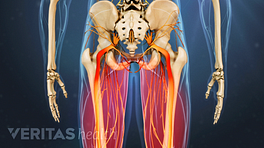There are multiple approaches when it comes to spinal fusion for spondylolisthesis, with doctors often approaching the spine using a posterior approach (from the back) or an anterior approach (from the front).
Posterior Fusion for Spondylolisthesis
A posterior fusion (approached from the back) with pedicle screw instrumentation is generally considered the gold standard of spinal fusion for spondylolisthesis. However, there is also an increasing acceptance that an accompanying fusion of the disc space can lead to a better fusion and increased stability.
About 80% of the stress goes through the disc space, so supporting the anterior column (the disc space in the front of the spinal column) with a fusion greatly increases the stiffness of the fusion construct. The manner in which the disc is fused is largely guided by the surgeon's preference.
Anterior Lumbar Interbody Fusion for Spondylolisthesis
Some surgeons prefer accessing the disc space through an anterior incision in the abdomen, called an anterior lumbar interbody fusion (ALIF).
An anterior approach affords the best exposure to the disc space. It allows a large device to be used for the fusion, increasing the surface area for a fusion to set up and allowing for more postoperative stability. An anterior approach often makes it possible for a better reduction of the deformity caused by the isthmic spondylolisthesis.
Jacking the disc open in the front re-establishes the patient's normal sagittal alignment, giving them a more normal inward curve to their low back. This approach does require an extra incision in the abdomen, in addition to an incision in the low back.
There is also the added risk of a great vessel injury, as the aorta and vena cava lie in front of the spine. However, with an experienced vascular and spine surgeon team, the risk of a vessel injury should be very low, and the benefits of added stability and fusion area very often outweigh the risks of the extra surgery.
For male patients having an ALIF at L5-S1, there is a risk of retrograde ejaculation, in which the ejaculation goes into the bladder. This is a 1% risk, and will often resolve spontaneously in about a year. The biggest problem retrograde ejaculation causes is increased difficulty in conceiving a child, although it is still possible.
Posterior and Transforaminal Lumbar Interbody Fusions
Another technique for accessing the disc space for a fusion is through an incision in the low back in a posterior approach, called a posterior lumbar interbody fusion (PLIF), or a transforaminal interbody fusion (TLIF). Approaching the disc space from the posterior has the benefit over an ALIF of requiring only one incision in the lower back.
However, only a limited portion of the disc space can be accessed from the back since the dural sac that contains the nerve roots is in the way. This limits the size of the interbody fixation device that can be used, and therefore can limit the added stability and fusion area. Furthermore, placing a device from the posterior into the disc space puts both the exiting and traversing nerve root at risk.
Read more about Types of Spinal Fusion







